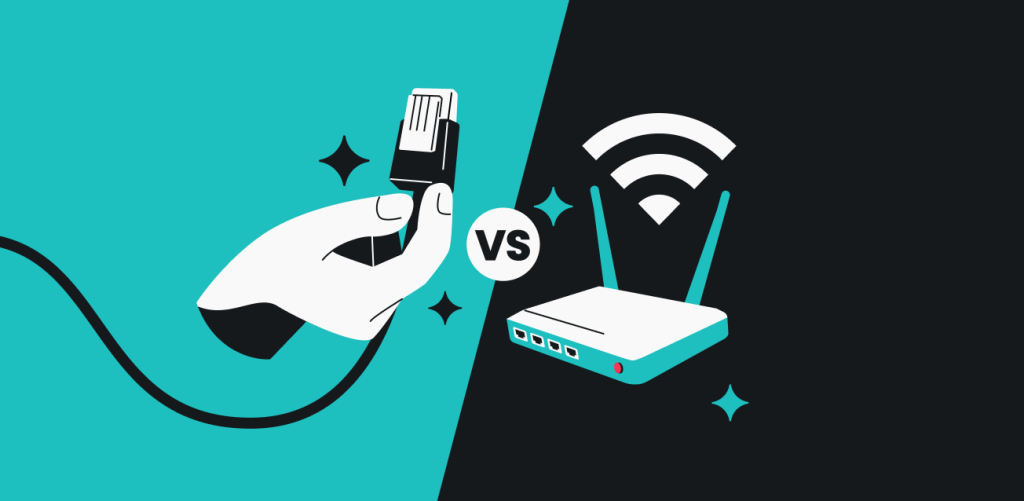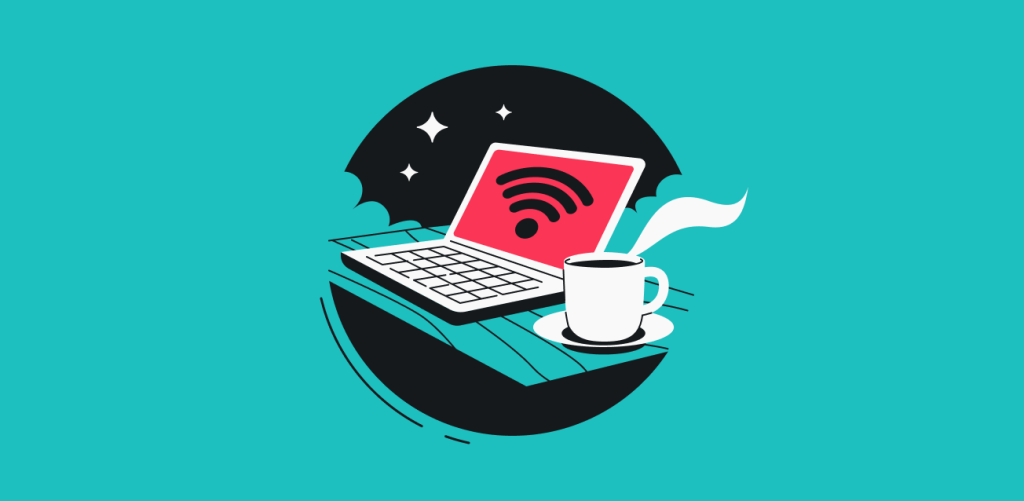
If left unprotected, your home Wi-Fi could become an easy target for cybercriminals and freeloaders. They might use your internet without permission, access your connected devices, snoop on your personal data, or even misuse your network for illegal activities.
Thankfully, it’s easy to bolster your home Wi-Fi security. Let’s go through the practical steps of effectively securing your home network.
Table of contents
Understanding your home Wi-Fi system
Before we get into how to secure your Wi-Fi network, it’s essential to familiarize yourself with its basic components. This will help you spot any potential security gaps and adjust settings to keep your network safe. Here’s a quick rundown:
- Router: often connected to a modem, it delivers internet to the devices in your home;
- Modem: brings internet into your home from your ISP (Internet Service Provider), usually provided by the ISP;
- Bands: Wi-Fi runs on different frequency bands:
- 2.4 GHz: offers broader coverage and better penetration through walls and obstacles but has slower speeds, common in older devices;
- 5 GHz: provides faster speeds with less interference but with a shorter range;
- 6 GHz: delivers even faster speeds and lower latency but has a shorter range than 5 GHz, which is found in newer routers.
- SSID (Service Set Identifier): the name of your Wi-Fi network that pops up when you search for available networks;
- Network devices or clients: the gadgets you connect to your Wi-Fi, such as computers, tablets, and mobile phones.
Guide to securing your router
There are several measures you can take to enhance your home Wi-Fi security. Below, you’ll find some of the most crucial ones.
Change default credentials
Your router credentials — separate from your network username and password — are used to access the admin panel where you manage security settings. These default credentials tend to be the same across devices, making them easy pickings for cybercriminals. Changing them will help protect your network from intruders.
Update your SSID
Most wireless routers come with a default SSID that includes the provider’s name and the router’s model. Keeping this default SSID makes it super easy for anyone to guess. To reduce the risk of unauthorized access, choose a unique SSID that doesn’t reveal identifiable or specific details.
Create strong passwords
A strong, unique password is one of your frontline defenses when securing your home Wi-Fi network. Avoid obvious choices like “homewifi,” “admin123,” and “password.” These may be easy to remember, but they’re just as easy for others to figure out. Instead, opt for a mix of uppercase and lowercase letters, numbers, and special characters.
Enable network encryption
Most routers come with an encryption feature that you should enable. This makes it significantly more difficult for third parties to snoop or get into your network. There are several types of encryption:
- WEP (Wired Equivalent Privacy) is the least secure encryption method and can be cracked easily;
- WPA (Wi-Fi Protected Access) has better security than WEP but is still susceptible to various vulnerabilities and is now considered outdated;
- WPA2 offers robust encryption and is common in routers made before 2018;
- WPA3 is the latest and most secure option, offering improved encryption and protection against brute-force attacks.
Always choose WPA3 if available. Using outdated encryption like WEP puts your home Wi-Fi security at serious risk, as hackers can easily tap into your network and access your data.
Disable WPS (Wi-Fi Protected Setup)
WPS is a feature that lets you fast-connect devices to your Wi-Fi network without entering your password by using an 8-digit PIN instead. However, this PIN can be easily guessed or brute-forced, leaving your network vulnerable even if you have a strong, unique password. Disabling WPS removes this weak point.
Update firmware regularly
Firmware updates typically include bug fixes and patches for vulnerabilities and security flaws. They may also introduce improved features and encryption methods to protect against the latest threats. Periodically checking that your router is running the latest version will help plug security gaps that could be exploited by malicious parties.
Switch off remote management
Remote management lets you control your router from anywhere, but it also creates opportunities for unscrupulous third parties to access your network settings. By disabling the feature, only the devices connected directly to your Wi-Fi can access your router’s settings.
Additional security measures
For an even more secure home network, there are a couple of additional measures you can take to further fortify your home Wi-Fi security. Let’s run through a few of them.
Set up a network for guests
Many routers allow you to set up a separate network with a different username and password, limiting the people who know your primary Wi-Fi network’s credentials. This separate setup also ensures that your main network and devices won’t be affected if your guests’ devices have malware or viruses.
Hide your network
Hiding your network SSID means it won’t show up when nearby devices scan for available networks. This reduced visibility lowers the risk of unauthorized access by home Wi-Fi stealers. However, note that with the right tools and skills, intruders can still detect and attempt to access your network.
Use firewalls and antivirus software
Routers usually have built-in firewalls that act as a barrier between your home network and the internet, adding an extra layer of security. Double-check that your router’s firewall is enabled to keep out viruses, malware, and hackers. To protect your devices in case anything sneaks past the firewall, consider using antivirus software like Surfshark Antivirus.
Use a VPN (Virtual Private Network)
A reliable VPN like Surfshark encrypts all the data transmitted over your home Wi-Fi network. Even if bad actors get on your network, they can’t read or mess with your sensitive information. Additionally, they can’t monitor your online activity, such as websites visited or files downloaded. Malicious actors aside, your ISP also won’t be able to track your online activity.
Secure IoT (Internet of Things) devices separately
IoT devices such as security cameras and thermostats are usually the weakest link in home security. Due to poorer security protocols, they often serve as an entryway for attacks because they’re easier to hack than your computer or phone. To protect your network, regularly audit the IoT devices connected to it. Even better, set up a separate guest network for these devices.
Risks of not securing your home Wi-Fi
Leaving your home Wi-Fi unprotected exposes you to the same dangers that threaten public Wi-Fi networks, which could harm your privacy, devices, and even financial and legal wellbeing. Here are some key risks to be aware of:
Unauthorized access and bandwidth theft
Hackers are always on the hunt for unsecured Wi-Fi, using techniques like Wi-Fi sniffing, wardriving (driving around to find vulnerable networks), and network scanning to find potential victims. If successful, they can manipulate this access to their advantage, such as tracking your online activity and leeching off your internet without permission.
Heightened vulnerability to attacks
An unsecured home Wi-Fi network tends to have multiple weak points that can serve as gateways for malicious actors to gain access and launch different types of attacks. Hackers might secretly intercept and tamper with your communication in a man-in-the-middle attack. Alternatively, they could steal your cookies to hijack your browser sessions.
Network control and misuse
Your unprotected network is vulnerable to bad actors who could seize control by modifying network settings, changing passwords, and creating backdoors. They might also misuse your network for more malicious purposes, such as redirecting traffic to harmful sites or exploiting resources for DDoS (Distributed Denial-of-Service) attacks and cryptocurrency mining.
Increased exposure to malware and ransomware
If your home Wi-Fi isn’t locked down tight, it becomes a prime target for cybercriminals to spread malware and ransomware. Once inside, they can track your online activity, steal your personal information like login credentials and banking details, and hold your data or devices for ransom.
Compromised connected devices
Once an intruder gets onto your home Wi-Fi, it’s easy for them to compromise your connected devices. They might introduce malware that spreads across all connected devices, rendering them unusable. They could also steal information stored on these devices, such as passwords, banking details, and sensitive files.
Legal and financial repercussions
If cybercriminals use your unsecured network for illegal activities, you could face serious legal consequences. Additionally, dealing with the aftermath of a cyberattack is no simple task and often involves significant financial costs — including expenses for recovery, legal services, and enhanced post-breach security measures.
How to secure your cameras and alarm systems
Cameras and alarm systems are crucial for home security. However, if not properly secured, their connection to your Wi-Fi network could introduce vulnerabilities that may compromise your network, data, and connected devices. Let’s check out some ways to ensure your security system doesn’t endanger your home network.
Ensure strong network security
Given how vulnerable IoT devices — like cameras and alarm systems — can be, it’s essential to bulk up your home Wi-Fi security to offset their weaknesses. A well-protected network can close security gaps, making it harder for malicious actors to target these devices or exploit their vulnerabilities to access your network and other connected devices.
Create a separate Wi-Fi network
Consider setting up a dedicated Wi-Fi network specifically for your security devices to limit the risks of cross-device breaches. So, if one of these devices is compromised, the threat remains contained. This will also keep your main network isolated from device-specific vulnerabilities, ensuring that the security devices don’t become a weak spot in your overall network.
Update firmware regularly
Just like your router, it’s crucial to regularly update the firmware on your camera and alarm system. These updates address known security flaws, include the latest security protocols and functionalities, and sort out bugs and glitches. Staying on top of firmware updates helps patch security gaps that could be exploited to gain access to your Wi-Fi network and devices.
Disable remote access
While convenient, remote access to your security camera and alarm system can jeopardize your home Wi-Fi network if you’re not careful. Disabling remote access when not needed reduces the risk of external attacks by limiting potential entry points for hackers. This ensures only devices on your home network can access your security systems.
Monitor network activity
Keeping a close eye on your network activity can help prevent your camera and alarm system from compromising your home Wi-Fi security. Frequently checking traffic makes spotting unusual patterns, unauthorized access, and suspicious data transfers easier — letting you catch potential breaches early.
Secure your home network — don’t leave it exposed
Home Wi-Fi can be vulnerable to unauthorized access, misuse, malware, and other threats if left unprotected. That’s why taking every step possible to improve your home Wi-Fi security is crucial. Start by renaming your SSID, using a stronger network password, and updating your router firmware.
While you’re at it, consider getting a VPN to cover any remaining security gaps and provide added privacy. It’s also a valuable tool if you’re frequently on the go and want to stay safe on public Wi-Fi networks.
FAQ
What is the best security for home Wi-Fi?
The best security for home Wi-Fi involves implementing both basic and advanced measures. Start by changing your router’s default credentials, creating a strong password, using the latest WPA3 encryption, and regularly updating your router’s firmware. Additionally, install a VPN on your router and secure your IoT devices separately for enhanced protection.
What security should I use on Wi-Fi?
To secure your Wi-Fi, use WPA3 encryption — the latest and most secure protocol currently available. WPA3 offers the strongest protection against unauthorized access, improved password and data transmission security, and advanced features to fend off attacks.
Can someone access my home Wi-Fi?
Yes, someone can access your home Wi-Fi if they have your network password or if your security settings are weak. You can monitor the list of connected devices from your router’s admin panel. To prevent unauthorized access, set a strong password, opt for WPA3 encryption, and keep your router’s firmware up to date.
Should I make my home Wi-Fi private?
Yes, you should make your home Wi-Fi private. Keeping your network private limits the number of people that can connect to it, significantly reducing the risk of security breaches and unauthorized access.
Can I check if someone is using my Wi-Fi?
Yes, you can check if someone is using your Wi-Fi by viewing the list of connected devices on your router’s admin interface. There’s also a wide range of monitoring apps and tools on the market to detect unauthorized devices on your network.



